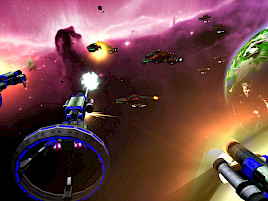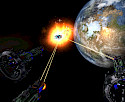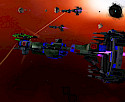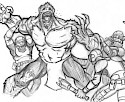Sword of the Stars Interview Part 2
Sword of the Stars Conversation, Part 2 - Multiplayer & AI
Part 1 | Part 2 | Part 3
StrategyCore had the opportunity to speak with Martin Cirulis, CEO/Lead Designer of Kerberos Productions, regarding his new 4x space strategy game, Sword of the Stars. The conversations and game play demo took place in the Destineer meeting room at this year’s E3. Destineer is distributing Sword of the Stars (SOTS) in North America. StrategyCore also spoke briefly with Mr. Cirulis at the Frogster Interactive booth (Frogster is distributing the game in Europe).
SC: What are the new elements in SOTS compared to previous 4x games?
MC: Well, new elements would be very robust multiplayer, first of all. It's not necessarily new but it's an evolution. SOTS is meant to be played single player but it's also meant to be seamless to multiplayer. You set up an up-to-eight player game, with people being able to join on-the-fly. They can quit and not ruin the game. If the person who set up the game pouts because he is getting beat up and quits, SOTS beams the turns to everybody else's computers so the game can resume. We go through Gamespy and Crossfire making it very easy to chat with people and set up the game.
SOTS also harkens back to the day of the old Spaceward Ho! game, which was a very fun little game in its day. It was a very elegant Windows app in the sense that you could have Spaceward Ho! running all day in the background of your machine. Every once in awhile it would cough at you and say "They're waiting for you!" and you would do a turn. SOTS uses much the same philosophy. SOTS is a very powerful game but it's also a very seamless Windows app. It will sit in the corner and will cough at you if it's your turn and you've missed it. It'll make a little trumpeting noise if you're expected to go into combat. You can set turn lengths to any one you want. And players can come and go at will. The three of us (Martin, Olav & Mike) could be playing for two hours. You might have to go for coffee or lunch. You set the AI to defend, which means that it won't waste your resources going after people. It just builds up your defenses and waits to see if somebody comes back. You log back in in two hours. Go on Crossfire, find the game and click back on it. Say "Hi guys, I'm back and I'm going to kick butt!" and away you go!
The star map is fully 3-D, which to some people seems like a gimmick but tactically and strategically it makes a huge difference. Think about Master of Orion. A 150 star map is huge. It takes a long time to hump your butt from one end to the other. When you're playing multiple races it's pretty clear that if there is one player here another player has to be over here on the other side. He has to be. It’s a 2-D plane so your whole strategy is based on that artificial planarity. Whereas with a 3D star map, 180 stars does not have that much room. You can be hit from any side. Your front lines become very fluid and you can't assume that because your enemy is here in the bottom corner that there is not another guy 45 degrees out, 30 degrees over. It makes for much less static game. You won't be able to build up a front of worlds, put a million ships there and then do everything else behind that front. SOTS makes that more difficult, especially as faster than light drive technology evolves. As each race develops their highest-end niche of travel power it doesn't become static.
SC: Did you ever play the game Ascendancy?
MC: Yup, I reviewed Ascendancy. Ascendancy was a game I so wanted to like. They were trying so hard and the sad thing was that it just kind of laid there. That was the tragedy.
SC: I think I played every single one of the 20-odd races, looking for something that was not there.
MC: It was a painful game for me to give them not a great review. Because all the things I loved were there but for single player it just kind of flopped around. I respect them for trying to break out of the standard mode. It's the same sort of thing we've tried for SOTS.
SC: Hopefully with more success. :)
MC: Yes, well certainly :). We have kicked the AI really, really hard. We have taught the AI lots of mean little tricks and will continue to do so.
SC: Is the AI self-teaching?
MC: I can give you the baloney answer. Its self-teaching which means by Thursday it'll take over the world and launch missiles at all of us. And then the Terminator will come from the future. But the reality is that if anyone tells you that is selling you a pile of baloney. The reality is that its reactive, which is a type of learning in the sense that it tries to understand what's happening to it. If it's entered a battle and it's lost, it asks itself "Why did I lose?" and it responds "Well, 92% of the damage I took was from missiles. Huh! Do I have a missile counter of any kind? If yes, I should build ships with it. If no, can I research it? If still no, what do I do? Well, if I'm getting missiles from long range, then I need to go after them really, really fast and hard or avoid them.
SC: Do you know of any other 4X game and has done that?
MC: I've seen claims of it and loose evidence of it here and there. I've played GalCiv2 recently. It seemed after a certain point to react to my weapon systems. And that's not bad. I think everyone kind of strives for that. The problem with an AI is that AI's are rarely clean. Which means you can go in with your best intent to say it'll do A, B and C but in reality it turns out that B turns off A when C has been activated. Which is why the best laid plans of mice and men in AI can come and go. I started my educational career as an AI major and that's why I've always been realistic about what a game can do. A game AI is about challenging the player. The deeper the game is the harder that is. That's just a simple truth. That's why if a developer claims to have both a deep game with an AI better than any human being could ever be, they're just lying. That's not how the world works. There is a computer chess champion of the world but there's not a computer Go champion of the world. There is a reason for that. And that is just one order of magnitude up. A 4X game is about 12 orders of magnitude more complex than a chess game. So our entire plan is to make the AI A) challenging and B) recognizable as the race it’s supposed to be. When you're fighting a Hiver AI it should give you the experience of fighting the Hivers. Same thing with the Liir. For instance, the Liir are less interested in killing you and more interested in resolving the situation. A Liir fleet will tend, not all a time but will tend, to try and blow the engines off their opponents and then break for long range. Or drive them into the planet.
SC: From your description of the Liir, that's actually what I was thinking they would do.
MC: Exactly. Whereas the Hivers, which are hierarchy based, tend to want to take out the command section. Their racial bias is: if you take out the brain, the body shuts down. They're also very big on your toughest ship. They assume that all your marbles are in your toughest ship.
SC: When you say toughest ship, do you mean most armor or most firepower?
MC: The AI tries to imagine what that would be. It doesn't cheat. It sees whatever ships are in scanning range, and goes "This is the largest ship I see.". If there's two of the same it goes "Which one has the bigger weapon systems that I can tell?" and it'll wait to see until you fire before it decides. But they will tend to glom on to that ship, which is not a bad strategy. That's their bias. And of course you try to mix it up a bit so it doesn't become a mindless exploit for someone to abuse all the time. For instance, I know that the Tarka raiders will tend to charge you because their nose sections are very heavily armored and very heavily armed. They will charge at high speed, make a pass, try and hurt you and then come around again. So I, as a player, will tend to stagger out my line a bit. Which means I'll have some ships taking the brunt of the attack and have two or three ships sniping as they come around. Which is good but it's not a mindless AI in the sense that it does the same thing time after time. Those ships will learn to split to either side or sometimes they'll mount something very scary on the rear so as they pass they will do bad, bad things to you.
SC: So will the AI learn if you pull away your strongest ship and then attack them from the sides as they go by?
MC: Defend in depth?
SC: Yes. Would the AI adjust for that?
MC: It adjusts in the sense that it questions why it’s losing. If you start defending in depth, it will go "The ship I want to kill is harming me less than these other ships. I should do something about that.". Like I said, its tendencies. We want to mimic that tendency. For instance, the American Navy deploys a certain way. They have two or three tactical doctrines and they will enter a fight in one of those ways. Now, if they start getting killed, the commander will change tactics. That's the kind of thing we're trying to simulate. You know your enemy. You can begin to anticipate general behaviors, but it's not tried and true every single time.
So ends Part Two of StrategyCore's conversation with Martin Cirulis, CEO and Lead designer of Kerberos Productions, developer of Sword of the Stars. Stay tuned for the next episode in this on-going tale.





